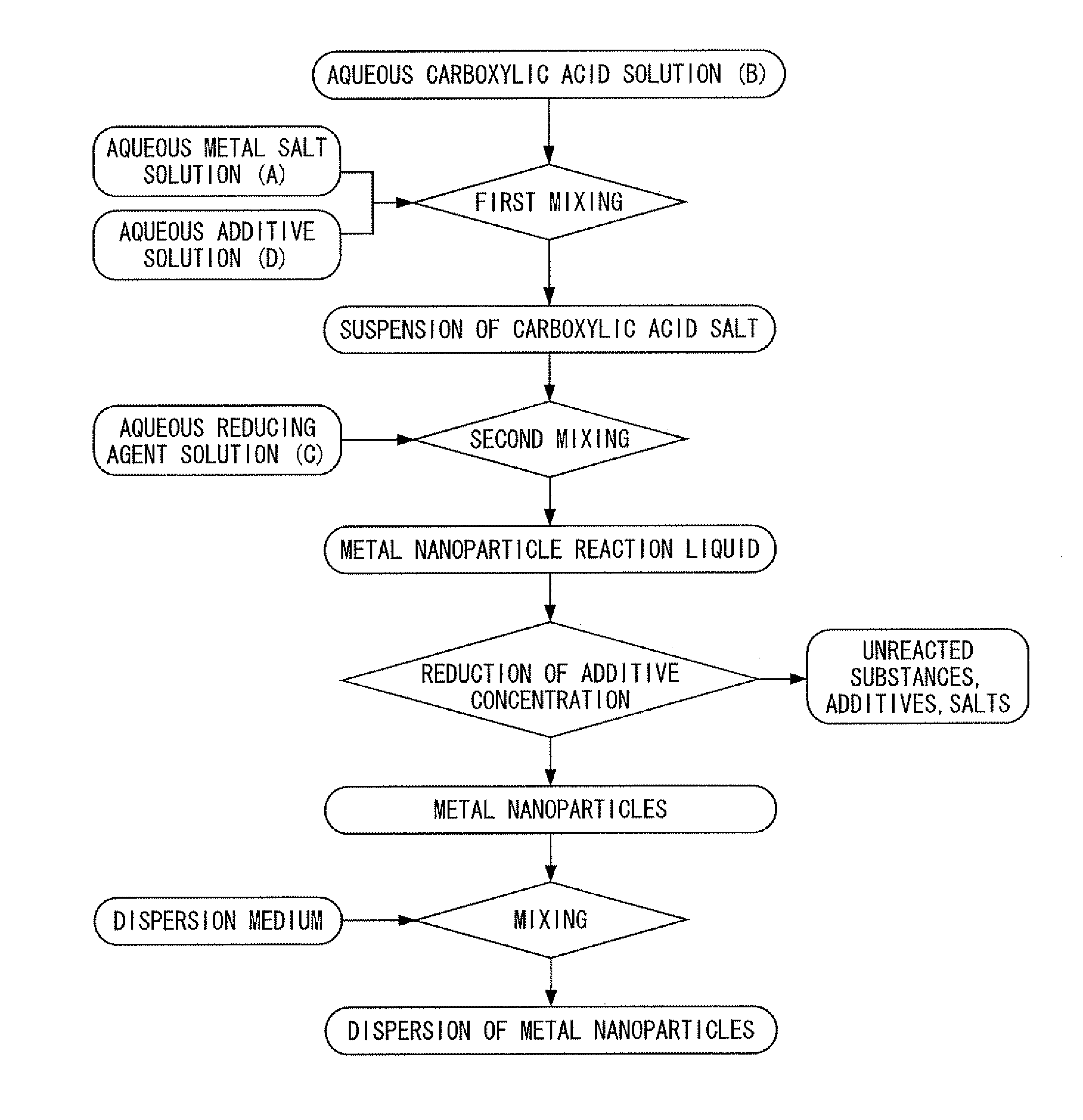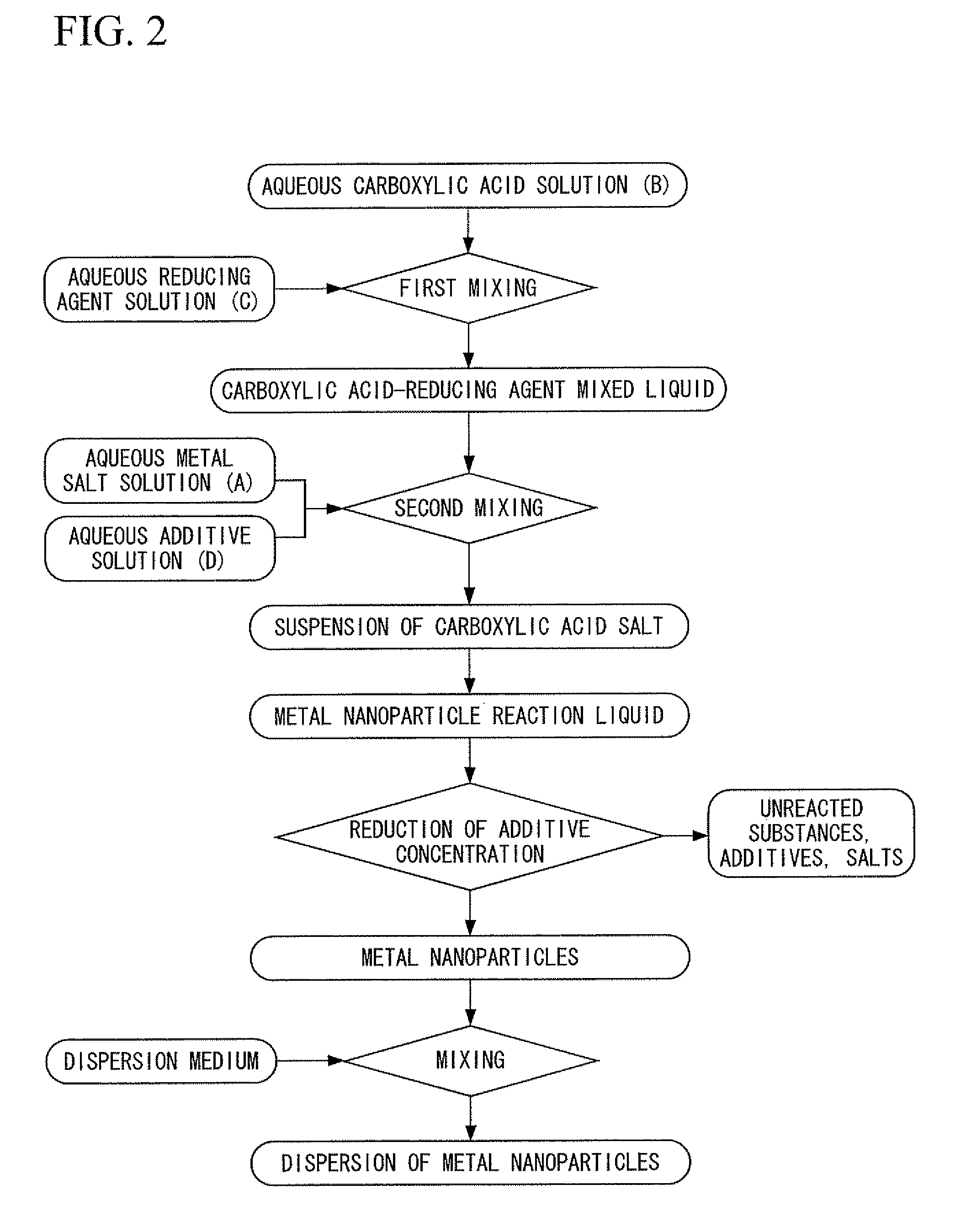Dispersion of metal nanoparticles, method for producing the same, and method for synthesizing metal nanoparticles
a metal nanoparticle and metal nanoparticle technology, applied in the direction of liquid/solution decomposition chemical coating, conductor, transportation and packaging, etc., can solve the problem of limited number of raw materials available for that use, and achieve the effect of reducing the solubility of formed metal complexes, improving the yield of carboxylic acid salts, and reducing precipitated carboxylic acid salts
- Summary
- Abstract
- Description
- Claims
- Application Information
AI Technical Summary
Benefits of technology
Problems solved by technology
Method used
Image
Examples
examples
[0383]The following provides a detailed explanation of examples of the present embodiments together with comparative examples thereof
Examples Relating to Embodiments According to [1] to [17]
example 21
[0400]First, silver nitrate was dissolved in deionized water to prepare an aqueous metal salt solution. In addition, chromium nitrate was dissolved in deionized water to prepare an aqueous additive solution. On the other hand, trisodium citrate was dissolved in deionized water, and particulate ferrous sulfate was added directly to the resulting aqueous trisodium citrate solution having a concentration of 26% in the presence of flowing nitrogen gas at a temperature of 35° C. and was dissolved to prepare a carboxylic acid-reducing agent mixed liquid containing citrate ions and ferrous ions at a molar ratio of 3:2. Next, under conditions where the nitrogen gas flow was maintained at a temperature of 35° C., while stirring the carboxylic acid-reducing agent mixed liquid by rotating a magnetic stirrer at a rotating speed of 100 rpm, the above-mentioned aqueous metal salt solution and the aqueous additive solution were dropped into the carboxylic acid-reducing agent mixed liquid and mixed...
example 22
[0401]A dispersion was obtained in the same manner as Example 21 with the exception of using tin nitrate instead of the chromium nitrate of Example 21. The dispersion was left at room temperature, and the aggregates of metal nanoparticles that settled were separated by decantation. Then deionized water was added to this separated product to form a dispersion, and after desalinating by ultrafiltration, the dispersion was further subjected to replacement washing with ethanol, and the content of the metal was adjusted to 50% by mass. This dispersion was designated as a first dispersion.
[0402]On the other hand, a dispersion was obtained in the same manner as Example 21, with the exception of using palladium nitrate instead of the silver nitrate of Example 21 and using tin nitrate instead of the chromium nitrate of Example 21. The dispersion was left at room temperature, and the aggregates of metal nanoparticles that settled were separated by decantation. Then deionized water was added t...
PUM
| Property | Measurement | Unit |
|---|---|---|
| temperature | aaaaa | aaaaa |
| thickness | aaaaa | aaaaa |
| particle diameter | aaaaa | aaaaa |
Abstract
Description
Claims
Application Information
 Login to View More
Login to View More - R&D
- Intellectual Property
- Life Sciences
- Materials
- Tech Scout
- Unparalleled Data Quality
- Higher Quality Content
- 60% Fewer Hallucinations
Browse by: Latest US Patents, China's latest patents, Technical Efficacy Thesaurus, Application Domain, Technology Topic, Popular Technical Reports.
© 2025 PatSnap. All rights reserved.Legal|Privacy policy|Modern Slavery Act Transparency Statement|Sitemap|About US| Contact US: help@patsnap.com



